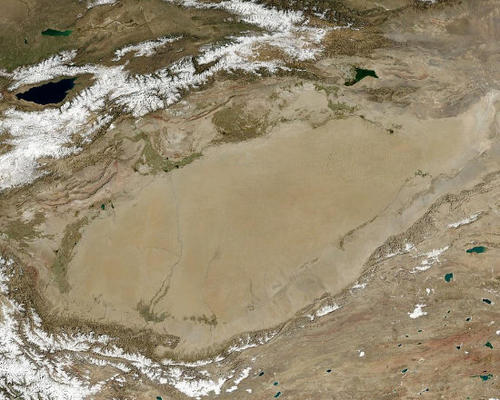Palaeoenvironmental changes in NW China
Tarim Basin - NW China
Image Credit: NASA Public Domain
Lake Bosten is the largest freshwater lake in northwest China and is mainly fed by precipitation and the Kaidu River. Today's climate there is characterised by severe aridity, but previous research has shown that the area was significantly more arid in the Holocene.
For a better understanding of regional palaeoenvironmental changes, new counts of pollen and non-pollen palynomorphs (NPPs) are presented from sediment core XBWu-46 collected in the southwestern part of Lake Bosten.
The data
The dataset includes counts and concentrations of pollen and non-pollen palynomorphs from sediment core XBWu-46 from Lake Bosten (Bosten Hu) over the last 8540 years. In addition, numbers of pollen are provided from a clay sample from the mud coffin BM28, Xiaohe Cemetery, Eastern Tarim Basin.
Publication of the data set: Tarasov, P et al (2018) https://doi.org/10.1594/PANGAEA.896290
Research results
In order to understand the changes in vegetation, climate, mountain inflow and settlement activities more precisely, species associations of spores and pollen grains from the last 8500 years were studied in the sediments of the former lake. In addition, a sample from a former cemetery was examined. This sample came from a mud coffin from the earliest burial layer of the Xiaohe cemetery.
The pollen analyses suggest that the climate can be roughly divided into three time periods. The first 4500 years in the middle Holocene (about 8540-4000 cal. years B.P.) were characterised by increasing aridity. In the last 2000 years, on the other hand, an increase in humidity could be observed. It is assumed that a change in precipitation patterns was caused by the westerly wind circulation, which replaced the Asian summer monsoon in the northwest. The timing of the cemetery sample (4155 - 3726 cal. years B.P.) dates the probable first settlement activities in the region.
Certain pollen suggest activities of the regional Andronovo culture, which probably settled the land agriculturally from the 4th millennium BC. Likewise, evidence of activities during the Han Dynasty (206 BC to 220 AD) could be observed, which can be linked to Silk Road activity.
Publication of the journal article: Tarasov, P et al (2018) https://doi.org/10.1016/j.palaeo.2018.11.038
Texts modified after: Tarasov, P et al (2018) https://doi.org/10.1016/j.palaeo.2018.11.038
